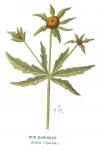Bur-Marigold.
 Bidens tripartita.
Bidens tripartita.
Also see Hool, 1922: Bur-Marigold.
Natural Order—Compositae.
Linnean System, Syngenesia; Order, Equalis.
The root of this plant is tapering, with many fibres attached to it. The stem is smooth, angular, solid, marked with small brown spots, erect, leafy, with opposite axillary branches. It grows to the height of from 2 to 3 feet. The leaves are opposite on winged stalks, of a dark green colour, smooth, serrated, acute or sharp pointed, in three segments, sometimes five (sometimes, however, the uppermost or the lowermost are found undivided). The flowers are in terminal heads, solitary, brownish-yellow in colour, and somewhat drooping. Each flower is surrounded by about eight spreading lanceolates, serrated or entire bracts of unequal size, hut all extending much beyond the flower-head. This plant grows in wet places, ditches, ponds, canals, and small rivers; but also in gardens upon comparatively dry land. It flowers from July to September.
Medicinal Properties: Diuretic, Astringent, Diaphoretic, Styptic, and Antiseptic.
It is employed in fevers, gravel, stone, bladder and kidney troubles, consumption, ulcerated lungs, general debility, ruptured blood-vessels, and, in fact, bleeding of every description, whether internal or external, for which it is a most excellent remedy. For bleeding from the lungs, bowels and stomach prepare it as follows:—
Bur-marigold, 2 oz.
Ginger, crushed, 1 oz.
Simmer in three pints of water down to one quart; when cool strain, and take half to one teacupful four or five times a day, or oftener if necessary.
For constipation, acute or chronic, and for piles of every description, the following compound is considered a specific:—
Bur-marigold, 1 oz.
Yarrow, 1 oz.
Lump Ginger, crushed, ½ oz.
Boil in four quarts of water down to two quarts; strain, and while hot add 3-lbs. of Black Treacle. (West Indian Molasses is the best for all medicinal purposes.) Stir until well mixed; when cold, from one wineglassful to half a teacupful may be taken three or four times a day before meals.
Health from British Wild Herbs was written by Richard Lawrence Hool, N.A.M.H., in 1918.

